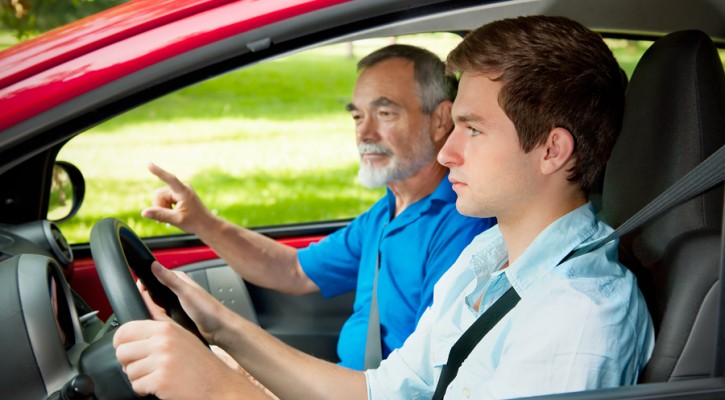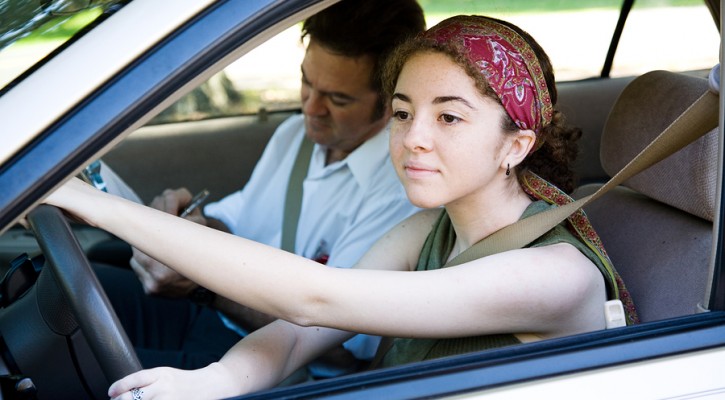Tag Archive: learners permit

Learn How to Drive on your Spring Break
February 25, 2011
Mention the word “Spring Break” and images of vacations and getaways come to mind. The reality is: not everyone gets to go on spring break. While this may dishearten some teens, the good news is: it’s a great time to learn how to drive!
Don’t exactly know where to start? Here are some suggestions on getting started on some spring break learning:
- Consider a visit to the DMV office. Different states have different requirements, so knowing these is a good start. Also, dropping by the DMV will allow you to get materials such as driver’s manuals to help aide your study. This can also be done online, with most states having their own official DMV site.
- Practice for your DMV written test online with a drivers license practice test. When completing the online course you’re guaranteed to pass your written test.
- If you’re already have your learners permit, get practice. Most states require a minimum of 50 hours, so running errands at home can sometimes be a way for new drivers to get experience driving, or completing required hours for driving. It’s the perfect time to familiarize one’s self with the vehicle, and properly operating it.
- Learn basic vehicle troubleshooting. Learn how to check the oil. Learn how to change a tire. Basically, learn the basics of being prepared for anything.
- Have fun. Imagine the surprise your friends will get when they find out you got started on learning how to drive. Driving is a lifelong skill that is both a convenience and a privilege, and there’s no better time to begin learning than when you have a break from your other responsibilities.

Graduated Drivers License Laws Around the United States
June 3, 2010
Young drivers in the United Stares are subject to many different laws, regulations and procedures. Many of the rules, regulations, privileges and limitations are similar from state to state but some also differ greatly. It would be overwhelming to compare the rules and regulations young drivers face in all 50 states. It’s easier to compare the policies of a handful of states. Many states differ on age young drivers can obtain their learner’s permits and driver’s licenses; they also differ on nighttime driving and passenger restrictions. Additionally the amount of supervised driving various from state to state and the length of time a young driver needs to have a learner’s permit before they can obtain a driver’s license various as well.
Minimum Age to Obtain a Leaner’s Permit
Many states allow teenagers to get their learner’s permits once they have turned 15. The minimum age to obtain a learner’s permit in Florida, Georgia and Texas is 15. In Colorado and Illinois 15 year olds can obtain their learner’s permits if they are enrolled in drives education. In California, teenagers must be 15 years and 6 months old before they can obtain their learner’s permits. Teenagers in New York are ineligible to obtain their permits until they turn 16.
Requirements to obtain a Driver’s License
After obtaining their learner’s permits young drivers are required to possess their permits for a specific amount of time until they are able to take their road tests (assuming they have reached the minimum age to take the toad test). In California, Texas and New York young drivers are only required to have a permit for six months before they take the road test for their driver’s licenses (or restricted licenses). In Illinois a permit is required for nine months before the road test can be taken. Colorado, Florida and Georgia require young drivers to keep their permits of a minimum of 12 months.
Before young drivers are able to get their licenses they are required to log a specific be amount of time behind the wheel. Most states require that 50 hours of driving time be completed and that 10 or 15 of those hours include nighttime driving. However, Texas only requires that 20 hours of driving being completed. But, at least 10 out of the 20 hours needs to be nighttime driving. Georgia requires that drivers complete at least 40 hours of driving and that at least 6 of the hours are night time driving.
In order to obtain a driver’s license or restricted license most states require that driver’s be at least 16 and have taken driver’s education. In order to get a driver’s license without taking a driver’s education course most states require the drivers to be 17 or 18. New York State issues a junior license to 16 year olds who have held their permits for at least 6 months. If they take driver’s ed they are eligible for their senior licenses at 17, if not, they must wait until their 18. For 16 year olds in Florida, they can take the road test for their license when they turn 16 regardless if they have taken driver’s education.
Driver’s License Restrictions
Most states do not give newly licensed 16 year old boys and girl complete freedom behind the wheel. Most states have nighttime driving restrictions and many states have restrictions on the number of passengers young drivers can have in their vehicles. For example, 16 year old drivers in Florida are not permitted to drive between 11pm – 6 am and 17 year old drivers in Florida are not permitted to drive between 1 am – 5 am. Drivers in New York adhere to restrictions from 9 pm – 5 am. And drivers in Colorado and Texas adhere to nighttime driving restrictions from 12 am – 5 am.
Out of the seven states compared here, Florida is the only one that does not have a restriction in place for the number of passengers young drivers are allowed to have in their vehicles. In California, for the first 12 months young drivers are not allowed to have any non-immediate family passengers under the age of 20 in their vehicles. In Colorado and Georgia, drivers are restricted to zero passengers for the first six months they have their license and no more than one for the second six months. In Texas, Illinois and New York young drivers are not allowed to have more than one passenger under the age of 21 in the vehicle. Again, immediate family members are an exception to the rule.
Teaching Your Teen To Drive During the Christmas Holiday Season
December 14, 2009
The Christmas season is supposed to bring out the best in us but, for drivers, it seems to bring out the worse. The mad rush to commute from work, get to the mall, and complete our shopping in a reasonable amount of time, makes this season one of the most dangerous driving periods of the year. With the arrival of the Christmas shopping season, parents, whose children are learning to drive on a learner’s permit, may be reluctant to let their teen drive in such a crazy driving environment.
Only you can decide whether or not your teen may be prepared to drive during this season. For a teen who only has a month or so of driving experience, it is probably not a good idea to allow them to drive in heavy Christmas traffic. However, for a teen with a good deal of driving experience, it is probably the best time to allow them to drive while you are in the seat next to them to give them guidance. This season presents a great teaching experience and an opportunity to open up a dialogue about how not to drive.
Before you and your teen venture out to the mall, you would be wise to discuss the driving environment and let the teen know what he or she can expect. You will need to exercise a great deal of patience, both with each other and with the other drivers on the road.
What kind of driving experiences and teaching moments can you and your teen expect?
Other Drivers
This season brings out the worst in drivers. If a driver cuts you off, tries to steal your parking space, or is honking the horn when you can’t move, don’t give into the urge to retaliate by gestures, honking your horn, or flashing your lights. You may wind up pushing an irate driver over the edge into a road rage situation where the other driver may try to attack you in some way. Both you and your teen should keep your cool, pay attention to your own safety and get out of the way of an irate driver as quickly as you can.
Remember that you can’t take the right-of-way, you can only give it up to someone else. If there is a conflict with another driver trying to take the right-of-way, it is much safer to give it to them.
Intersections
Several problems will be encountered at intersections. First, and most dangerous, will be those impatient drivers who will step on the gas in hopes of beating a red light. Many drivers will deliberately run the red light. Once your light turns green, don’t be in a hurry to go. Have your teen look in all directions to make sure that no one is trying to run the red light before proceeding.
The other issue you will have to contend with are those drivers who pull forward into intersections when traffic ahead is stopped and wind up blocking the intersection when the light changes. Your teen will need to stop at the stop line before the intersection and wait until traffic ahead has cleared enough to allow her to proceed completely through the intersection.
Pedestrians
There is probably no time of year where we encounter more pedestrians on the road. Remember that pedestrians in a crosswalk, whether marked or not, always have the right-of-way. Pedestrians can’t move as fast as a car can, especially when they are burdened down with packages, so don’t expect them to jump out of your way. Remember also that pedestrians may not hear you coming. Their minds are occupied just like yours. Their ears may be wrapped in a muffler or a hat or the pedestrian could be totally deaf.
Be careful and have a safe and enjoyable holiday season.
Additional Driver Safety Tips for the Holiday Seasons:
http://alerts.nationalsafetycommission.com/2009/10/holiday-driving-halloween-safety-tips.php
http://alerts.nationalsafetycommission.com/2009/11/thanksgiving-traffic-safety-2009.php

Why You Should Take a Drug and Alcohol Course: A Note about Marijuana and Driving
January 5, 2009
Of course, a Florida drug and alcohol course is mandatory; you’ll have to take it so you can get your driver’s permit. But a certificate isn’t the only thing you should take away from the class – the knowledge you gain could one day save your life.
Drinking alcohol and driving gets a lot of attention, both in driver’s education courses and in the media, and it should; many teens die in alcohol-related crashes each year. But some teens forget about or ignore the effects of illegal drugs on driving, particularly with drugs that are incorrectly perceived to be harmless, like marijuana. But marijuana, whether used alone or in combination with alcohol, is anything but harmless for any driver.
By far, marijuana remains the most widely used illegal drug among teens. The main active chemical in marijuana is THC (delta-9-tetrahydrocannabinol). Short-term effects of marijuana use include problems with memory and learning, distorted perception, difficulty in thinking and problem-solving, loss of coordination, and increased heart rate, anxiety, and panic attacks.
After alcohol, marijuana is the substance most frequently found in fatal automobile crashes. Even a moderate dose of marijuana can impair driving performance. Alcohol and marijuana are also often found together, resulting in a dramatic spike in impairment levels and decreased driving performance. The effects of a low dose of marijuana combined with alcohol are much greater than for either drug alone.
Combining any two drugs, or a drug with alcohol, may result in the synergistic effect. This means that the combination of drugs produces effects that are greater than the sum of the effects of the two drugs. This is called an additive effect; instead of a 1 + 1 = 2 result, the synergistic effect may cause a 1 + 1 = 3 result.
Remember, any drug that affects your safe driving can mean a DUI – or worse.
Getting your Florida learner’s permit requires certain steps. Here is a useful Learners Permit checklist to get you started.

How to Get a Florida Learner’s Permit
December 5, 2008
So, you’re fifteen years old and ready to get your Florida Learner’s Permit. Congratulations! You are about to take the first step towards increased freedom and independence – but along with that comes increased responsibility. You’ll need to follow certain steps to get your learner’s permit. Here’s how to make the process as smooth as possible.
First, try to plan ahead. Many new drivers want to get their regular driver’s licenses as soon as they turn 16, but you need to have held a learner’s license for at least one year without any traffic convictions before you apply for your operator’s license.
When you go to the DMV, you’ll need appropriate identification. You’ll also need a certificate of completion for the Traffic Law and Substance Abuse Education course. Your parent or legal guardian will need to sign a consent form. Then you’ll be ready to take the written test!
The written test consists of 20 questions about road rules and 20 questions about road signs. You must answer 15 out of 20 questions correctly to pass each test. Then you’ll take a vision test and a hearing test right there at the DMV.
Once you earn your learner’s permit, you must comply with certain restrictions to keep it. You can never drive alone with a learner’s permit, no matter how old you are. You may only drive during daylight hours during the first three months and until 10 p.m. thereafter, always with a licensed driver who is at least 21 years old and occupies the front passenger seat.
You’ll need to follow all traffic laws carefully, both to develop safe driving habits and to avoid further restrictions. If you receive a moving traffic conviction while you have a learner’s license, the one-year period you are required to hold your learner’s license will be extended for one year from the date of the conviction or until you are 18 years old, whichever happens first.
If you receive six points on your driving record within a 12-month period, your driving privileges are automatically restricted to business purposes only for 12 months or until you are 18, whichever happens first. If you receive additional points during this restricted period, the restriction is extended 90 days for each additional point.
In addition, drivers under the age of 21 with a blood alcohol level of .02% or more will have their license immediately suspended for six months. This administrative action is for a first offense; a second offense will result in a one-year suspension. Refusal to submit to testing results in a suspension of twelve months for a first offense and eighteen months for a second offense.
If you are truant in your school attendance, your driving privilege will be suspended until you provide proof you have attended school for 30 consecutive days.
As you can see, once you get your learner’s permit, you’ll need to drive very safely to keep it and to earn your operator’s license. Taking this responsibility seriously will go a long way towards earning your place in society as a trustworthy adult.
